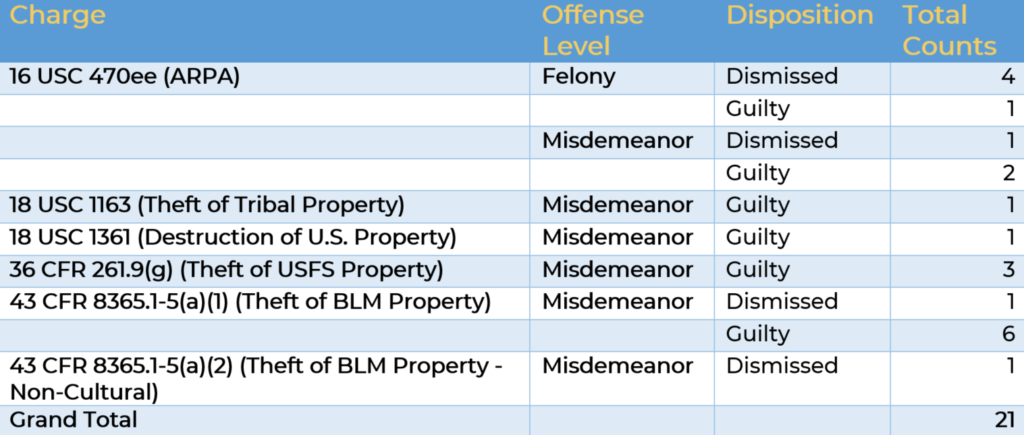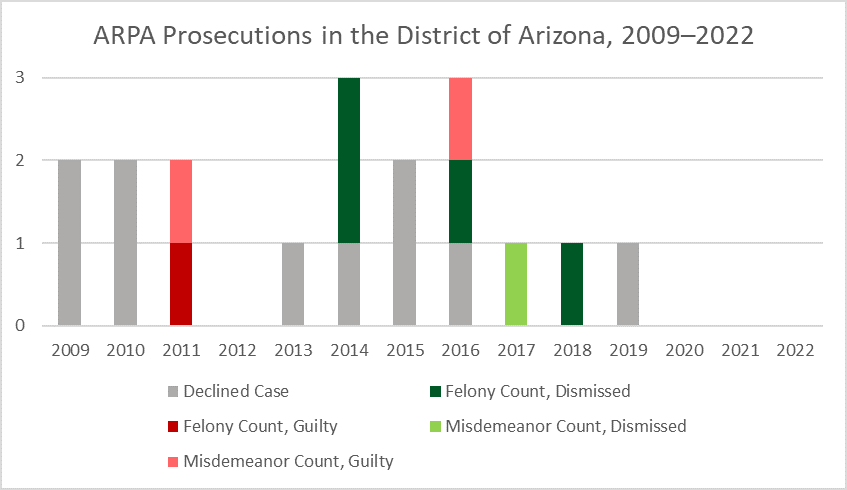How Often Are Heritage Resource Crimes Prosecuted in Arizona?
Shannon Cowell, John R. Welch, and Randy Ream
On a daily basis our team works both proactively, to deter heritage crime through outreach and capacity building within Tribes, and responsively, to investigate archaeological looting and vandalism incidents. Through coordination and training, we prepare ourselves and our colleagues in law enforcement and resource management to launch investigative and damage assessment processes whenever and wherever needed. In the four years since the establishment of the cooperative assistance agreement between the U.S. Bureau of Indian Affairs and Archaeology Southwest, we have completed eight damage assessments and responded to an additional 32 reports of sites being looted.
Assessing Prosecutorial Discretion
Regardless of the quantity and quality of heritage resource crime investigations, prosecutors have the final say in deciding whether cases will be made based on the actions of looters and grave robbers. On federal public lands and Tribal lands, United States Attorney’s Offices choose which cases to take and whether those cases will be prosecuted as felonies or misdemeanors.
For this reason, we set out to learn more about the frequency and seriousness of U.S. Attorney’s Office prosecutions under the Archaeological Resources Protection Act (16 U.S.C. §470, “ARPA”) and related laws. According to a 2007 paper in the Yearbook of Cultural Property Law, U.S. Attorney’s Offices nationwide charged 259 suspects with ARPA violations during the decade from 1996 to 2005. Eighty-three of these defendants were convicted; 20 were incarcerated. Given that only the best cases ever even make it to the desk of an Assistant U.S. Attorney (AUSA), it was surprising that only 32% of defendants were convicted and less than a quarter of those did prison time.
What’s happened since 2005? We consulted the national caseload data available from the U.S. Department of Justice (DoJ). This database tracks events in every federal criminal court case, making it challenging to compile parallel data sets for statistical analysis of multiple cases. Still, caseload data provides the best way to find archaeological resource crimes and gather enough details to retrieve court documents from PACER, a federal judiciary database.
We soon discovered that searching for statistics about recent prosecutions of heritage resource crimes is complicated! Because the publicly available data isn’t cleaned, corrected, or filtered, we submitted a FOIA request in May of 2021. We received the DoJ response 21 months later, in early 2023. While we waited, Cowell learned to read and interpret the “tea leaves” sprinkled throughout the DoJ databases. Cowell’s sleuthing allowed us to respond to requests from several of our partner Tribes regarding prosecution outcomes, and to learn specifically about indictments and case dispositions in our home state, the District of Arizona.
The following provisional results are based on information retrieved from both databases; each entry from the national caseload data was cross-checked against court documents available via PACER.
Heritage Crime Referrals
In the roughly 13 years between January 2009 and June 2022, seven federal agencies made 28 referrals of ARPA and other crimes related to the destruction of apparent archaeological resource crimes to the U.S. Attorney’s Office for the District of Arizona. The top three referral agencies were the Bureau of Land Management, the Forest Service, and the Bureau of Indian Affairs.
Seventeen of these cases listed ARPA as the lead charge. Prosecutors declined ten (59%) of these ARPA cases, mostly citing weak or insufficient evidence as the reason.
Prosecutors also declined three criminal Native American Graves Protection and Repatriation Act (18 USC §1170, “NAGPRA”) violations and referred these cases to other jurisdictions during this period. Our sources do not indicate where these cases were referred.
Heritage Crime Prosecutions

Prosecution Counts by Charge, Offense Level, and Disposition in the District of Arizona, 2009–2022
During this same 13-year period, the District of Arizona filed charges for 21 counts of heritage crime violations committed by 19 individuals. Outcomes for all prosecuted heritage-related counts are summarized in the table below.
Also from 2009 to 2022, eight counts of ARPA were filed against seven defendants (see graph below). Two defendants were found guilty of two ARPA misdemeanor counts; one misdemeanor ARPA count and four of the felony ARPA counts were dismissed. The most recent successful felony conviction of ARPA in the District of Arizona was in 2011, and the most recently incarcerated defendant was convicted in 2011.

ARPA Prosecution Dispositions in the District of Arizona, 2009–2022
Conclusions
Our previous blog post, Heritage Resource Looting and Vandalism in Arizona: How Serious is the Problem?, estimates that at least 2,157 instances of looting and vandalism occurred in Arizona during the 13 years represented by the data above. The disparity between thousands of incidents and three guilty verdicts is both unsettling and worthy of further inquiry.
The grim reality is that many, and probably most, heritage resource crimes go undetected. Of those that are detected, primarily by Arizona State Site Stewards, the great majority go unaddressed. Even when agencies respond and perpetrators are identified, most go unpunished. It seems that Tribes, archaeologists, and land managers need to collaborate to provide more, and more persuasive, information and perspective about heritage resource crimes to prosecutors, politicians, and the public. Please join us in this important quest.
